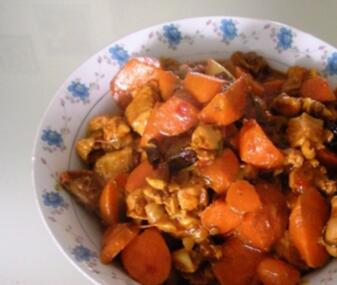
Yellow pot chicken - huang men ji (黄焖鸡)
Back in 2008 we posted a yellow pot chicken recipe, but as with all popular dishes, there are several variations out there with their own distinctive flavors. This particular recipe adds carrots as well as local chili peppers and bean paste from Sichuan to create a complex but balanced dish. We find that the sweetness of the carrots is ideal for drawing out the pungent saltiness of the bean paste and the tangy heat within the peppers.
The chili peppers used in this recipe are the small fiery variety known as xiaomila (小米辣) in Chinese. The xiaomila grown in Qiubei (丘北), a county in southeastern Yunnan, are considered to be the most 'authentic', but if you cannot find chilies from Qiubei, standard Chinese chilies will suffice. In addition to lighting up the taste buds, xiaomila are also known for their health benefits, which include lowering blood pressure, reducing the risk of diabetes, providing pain relief and increasing metabolism.
The pungent bean paste used in this recipe is known in Chinese as doubanjiang (豆瓣酱), which is commonly available at dry markets around Kunming or Asian supermarkets around the world. The most popular variety of doubanjiang comes from Pixian (郫县), Sichuan and is made from fermented soy and fava beans plus chilies and spices.
As with the standard version of yellow pot chicken, this recipe uses black cardamom, known as caoguo (草果) in Chinese, and sometimes referred to as brown cardamom or tsaoko in English. Black cardamom is much larger than regular (green) cardamom (doukou, 豆蔻) and less fragrant. Should you be unable to obtain black cardamom, three or four green cardamom pods can be used as a substitute.
Ingredients
½ chicken—medium size
8-9 medium-sized carrots
3 sprigs green onion
2 shallots
Handful of fresh ginger slices
1 pinch of Sichuan peppercorns (花椒)
4 pieces star anise
Handful of whole dried xiaomila or red chili peppers*
1 black cardamom pod (草果)
2 teaspoons sugar
1 teaspoon salt
1 tablespoon doubanjiang
1 tablespoon chili sauce (辣椒酱)
Oil for frying
Approximately 2 cups of water
Optional: 1-2 tablespoons of curry powder
*Make sure to wash your hands thoroughly after handling chilies!
Method
Wash the chicken thoroughly and chop it into small bite-sized pieces - you can also request that a butcher chop the chicken for you.

Chop the carrots at a diagonal slant into chunks about 3 cm wide.
Peel the shallots and leave them whole. Chop the spring opinion into 2 cm pieces. Cut the black cardamom pod in half.
Pour a few tablespoons of oil into the wok—just enough to form a small pool at the bottom for stir frying the ginger and spices. Turn up the heat to high. Add in the shallots and the ginger. Cook for a few seconds.

Add in the rest of the spices, the Sichuan peppercorns, star anise, chili peppers, black cardamom, sugar and salt. Then add the bean paste and chili sauce and stir until evenly distributed. Finally, pour the chicken pieces into the wok.
Stir fry until the chicken is golden, making sure to stir constantly so the chicken cooks evenly and thoroughly.

Once the chicken is cooked, add in the carrot chunks. Pour in around two cups of water, enough so that a broth forms. Sprinkle the green onion on top.

Place a lid onto the wok. Keep the heat on high until the broth bubbles, then turn the heat down to low. Stir occasionally. Simmer until the carrots are tender and you can easily pierce them with a fork or chopstick. Turn off the heat.
If so desired, stir in a tablespoon or more of curry powder when the chicken is simmering. This will give your dish a curry undertone. (Note: This correspondent loves curry and used two tablespoons.)
Serve with rice. Enjoy!
© Copyright 2005-2024 GoKunming.com all rights reserved. This material may not be republished, rewritten or redistributed without permission.











Comments
Yay bring back the recipes!! :)
You even have RECIPES on here? I wonder what GoKunming doesn't do :P As a serial cook and food lover I'll give this a go, it looks yummy!
Oh yeah,, the recipes are back! (damn, Ian beat me to it. Oh well, it deserves double recognition). Some of the recipes from 2008/2009 are still some of my favourite Chinese dishes. More please.
Login to comment